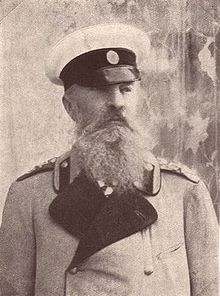State Council (Russian Empire)

The State Council ( Russian Госуда́рственный сове́т / Gossudarstwenny sowet ; German also Reichsrat ) was the highest legislative body in the Russian Empire from 1810 to 1906, and from 1906 to 1917 as the upper chamber of the parliament, the legislative body.
history
The predecessor of the State Council of the Russian Empire was on March 30th July. / April 11, 1801 greg. created "Unconditional Council" (Russian Nepremenny sowet ), which was also unofficially referred to as the Council of State .
From 1810 to 1906
The State Council was established by a manifesto of Tsar Alexander I on January 1st jul. / January 13, 1810 greg. convened. Its creation was one of the elements of the plan drawn up by Mikhail Speransky for the restructuring of the Russian state.
The members of the State Council were appointed by the Tsar. Although any person could become a member of the State Council, the absolute majority was always made up of nobles , usually for life. The membership grew from 35 in 1810 through 60 in 1890 to 90 at the beginning of the 20th century.
Ministers were automatically members of the Council of State. The chairman and his deputy were appointed annually by the tsar; if the tsar was present at meetings of the Council of State, he automatically assumed the chairmanship for their duration. From 1812 to 1865 the chairman of the State Council was also chairman of the Council of Ministers (Komitet ministrow) . During the existence of the State Council and its predecessor from 1801 to 1906, the State Council had 548 different members.
From 1906 to 1917
As a result of the events of the revolution of 1905 , the State Council was established by the manifesto of Tsar Nicholas II on February 7th July. / February 20, 1906 greg. and the new version of the Basic Law of April 10th jul. / April 23, 1906 greg. converted into the supreme legislative body of the empire. From then on it represented the upper chamber of the newly created parliament; lower chamber was the State Duma .
Half of the members of the State Council has also been appointed by the Tsar, the other half was chosen after five categories: 6 members of the Russian Orthodox Church , 18 by Adel companies, one member of the zemstvo assemblies of the provinces , 6 of the Academy of Sciences and the universities as well as 12 of the exchange committee and commercial offices; there were also two representatives from the Parliament of the Grand Duchy of Finland . The number of elected members of the Council of State was revised annually on January 1st. The number of members appointed by the Tsar could not exceed this and was initially 98, making the total 196.
The semstwov representatives in the State Council were each elected for three years, all other elected members for nine years, with one third of the members in each category being rotated after three years. At least 40 years of age with the right to vote for the State Duma and at least intermediate education could be elected, but no foreign nationals. The chairman and vice chairman of the Council of State continued to be chosen by the tsar from among the appointed members.
During the February Revolution , Nicholas II gave Jul. / March 10, 1917 greg. a ukase about the interruption of the work of the Council of State, which should be resumed at the latest in April. However, that did not happen. In May 1917, the Provisional Government abolished the position of appointed State Councilor; After the October Revolution , the Council of State was finally dissolved in December 1917 by a decree of the Council of People's Commissars .
Chairman of the Council of State
1810 to 1906
- Count Nikolai Rumjanzew (1810–1812)
- Prince Nikolai Saltykov (1812–1816)
- Prince Pyotr Lopukhin (1816–1827)
- Prince Viktor Kotschubei (1827–1834)
- Count Nikolai Novossilzew (1834–1838)
- Prince Illarion Wassiltschikow (1838–1847)
- Count Wassili Lewaschow (1847–1848)
- Prince Alexander Tschernyschow (1848-1856)
- Prince Alexei Orlow (1856–1861)
- Count Dmitri Bludow (1862–1864)
- Prince Pawel Gagarin (1864–1865)
- Grand Duke Konstantin Nikolajewitsch (1865–1881)
- Grand Duke Mikhail Nikolajewitsch (1881–1905)
- Count Dmitri Solski (1905–1906)
1906 to 1917
- Eduard Frisch (1906–1907)
- Mikhail Akimov (1907-1914)
- Sergei Manuchin (1914)
- Ivan Golubev (1915)
- Anatoly Kulomsin (1915-1916)
- Ivan Shcheglowitov (1917)
Members
See category: Member of the Russian State Council .
Meeting place
Since 1810, the State Council has met in a room on the ground floor of the Saint Petersburg Winter Palace . After the unsuccessful assassination attempt on Tsar Alexander II on February 5th, July / February 17, 1880 greg. For security reasons, it was proposed to move the State Council meeting to another building. From 1885 to the dissolution of the State Council in 1917, the State Council served the Mariinsky Palace (Marienpalast) on St. Petersburg's Isaaksplatz opposite the Isaac's Cathedral . During a renovation in connection with the expansion of the State Council between 1906 and October 15, jul. / October 28, 1908 greg. a hall in the building of the St. Petersburg Nobility Assembly was used.
literature
- Article State Council in the Great Soviet Encyclopedia (BSE) , 3rd edition 1969–1978 (Russian)
- State Council in Brockhaus-Efron (Russian)

